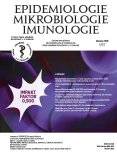A new definition of sepsis (Sepsis-3) – aims, advantages, and controversies
Authors:
J. Máca 1,2; P. Sklienka 1,2; P. Reimer 1; M. Holub 3
Authors‘ workplace:
Klinika anesteziologie, resuscitace a intenzivní medicíny, Fakultní nemocnice Ostrava-Poruba
1; Katedra intenzivní medicíny a forenzních oborů, Lékařská fakulta, Ostravská univerzita v Ostravě
2; Klinika infekčních nemocí 1. lékařské fakulty Univerzity Karlovy a Ústřední vojenské nemocnice – Vojenské fakultní nemocnice
3
Published in:
Epidemiol. Mikrobiol. Imunol. 67, 2018, č. 1, s. 36-43
Category:
Review Article
Overview
Sepsis is a life-threatening condition caused by a dysregulated host response to infection. Over the last decades, the approach to sepsis is evolving dramatically, mainly as a result of a rapid increase in the knowledge of its epidemiology, physiopathology, and management. In this context, the new international criteria and definition for sepsis, The Third International Consensus Definitions for Sepsis and Septic Shock (Sepsis-3), were introduced in 2016. The criteria were established consensually by the Task Force which consisted of experts from the Society of Critical Care Medicine and the European Society of Intensive Care Medicine. The main goal is the expansion of awareness of the professional public about this medical condition with a high fatality rate, particularly when not diagnosed and treated early. Sepsis-3 should also serve as a benchmark for future preclinical and clinical research, development of new diagnostic methods, and the terapy of patients with sepsis and septic shock.
Keywords:
sepsis – septic shock – organ dysfunction – definition – criteria
Sources
1. Bone RC, Balk RA, Cerra FB, et al. Definitions for sepsis and organ failure and guidelines for the use of innovative therapies in sepsis. The ACCP/SCCM Consensus Conference Committee. American College of Chest Physicians/Society of Critical Care Medicine. Chest 1992;101(6):1644–1655.
2. Levy MM, Fink MP, Marshall JC, et al.; SCCM/ESICM/ACCP/ATS/SIS. 2001 SCCM/ESICM/ACCP/ATS/SIS International Sepsis Definitions Conference. Crit Care Med 2003;31(4):1250–1256.
3. Singer M, Deutschman CS, Seymour CW, et al. The Third International Consensus Definitions for Sepsis and Septic Shock (Sepsis-3). JAMA 2016;315(8):801–810.
4. Mayr FB, Yende S, Angus DC. Epidemiology of severe sepsis. Virulence 2014;5(1):4–11.
5. Singer M. The new sepsis consensus definitions (Sepsis-3): the good, the not-so-bad, and the actually-quite-pretty. Intensive Care Med 2016;42(12):2027–2029.
6. Dombrovskiy VY, Martin AA, Sunderram J, et al. Facing the challenge: decreasing case fatality rates in severe sepsis despite increasing hospitalizations. Crit. Care Med 2005;33(11):2555–2562.
7. Dombrovskiy VY, Martin AA, Sunderram J, et al. Rapid increasein hospitalization and mortality rates for severe sepsis in the Uni-ted States: a trend analysis from 1993 to 2003. Crit Care Med 2007;35(5):1244–1250.
8. Iwashyna TJ, Cooke CR, Wunsch H, et al. Population burden of long-term survivorship after severe sepsis in older Americans. J Am Geriatr Soc 2012;60(6):1070–1077.
9. Dellinger RP, Levy MM, Rhodes A, et al. Surviving Sepsis Campaign Guidelines Committee Including the Pediatric Subgroup. Surviving Sepsis Campaign: international guidelines for management of severe sepsis and septic shock: 2012. Crit Care Med 2013;41(2):580–637.
10. Vincent J-L, Marshall JC, Namendys-Silva SA, et al. ICON Investigators. Assessment of the worldwide burden of critical illness: the Intensive Care Over Nations (ICON) audit. Lancet Respir Med 2014;2(5):380–386.
11. Iwashyna TJ, Ely EW, Smith DM, et al. Long-term cognitive impairment and functional disability among survivors of severe sepsis. JAMA 2010;304(16):1787–1794.
12. Martin GS, Mannino DM, Eaton S, et al. The epidemiology of sepsis in the United States from 1979 through 2000. N Engl J Med 2003;348(16):1546–1554.
13. Torio CM, Andrews RM. National inpatient hospital costs: the most expensive conditions by payer, 2011. Statistical Brief #160. Healthcare Cost and Utilization Project (HCUP) Statistical Briefs. August 2013. Dostupné na www: http://www.ncbi.nlm.nih.gov/books/NBK169005/. Accessed October 31, 2015.
14. Vincent JL Dear SIRS, I‘m sorry to say that I don‘t like you... Crit Care Med 1997;25(2):372–374.
15. Kaukonen KM, Bailey M, Pilcher D, et al. Systemic inflammatory response syndrome criteria in defining severe sepsis. N Engl J Med 2015;372:1629–1638.
16. Singer M, De Santis V, Vitale D, et al. Multiorgan failure is an adaptive, endocrine mediated, metabolic response to overwhelming systemic inflammation. Lancet 2004;364(9433):545–548.
17. Hotchkiss RS, Swanson PE, Freeman BD, et al. Apoptotic cell death in patients with sepsis, shock,and multiple organ dysfunction. Crit Care Med 1999;27(7):1230–1251.
18. Churpek MM, Zadravecz FJ, Winslow C, et al. Incidence and prognostic value of the systemic inflammatory response syndrome and organ dysfunctions in ward patients. Am J Respir Crit Care Med 2015;192(8):958–964.
19. Seymour CW, Coopersmith CM, Deutschman CS, et al. Application of a Framework to Assess the Usefulness of Alternative Sepsis Criteria. Crit Care Med 2016;44(3):e122–130.
20. Shah RU, Henry TD, Rutten-Ramos S, et al. Increasing percutaneous coronary interventions for ST-segment elevation myocardial infarction in the United States: progress and opportunity. JACC Cardiovasc Interv 2015;8(1ptB):139–146.
21. Sprung CL, Schein RMH, Balk RA. The new sepsis consensus definitions: the good, the bad and the ugly. Intensive Care Med 2016;42(12):2024–2026.
22. Shankar-Hari M, Phillips GS, Levy ML, et al. Developing a new definition and assessing new clinical criteria for septic shock: for the Third International Consensus Definitions for Sepsis and Septic Shock (Sepsis-3). JAMA 2016;315:775–787.
23. Rhodes A, Evans LE, Alhazzani W, et al. Surviving Sepsis Campaign: International Guidelines for Management of Sepsis and Septic Shock: 2016. Intensive Care Med 2017;43(3):304–377.
Labels
Allergology and clinical immunology Dermatology & STDs Paediatric dermatology & STDs Hygiene and epidemiology Medical virology Clinical microbiology LaboratoryArticle was published in
Epidemiology, Microbiology, Immunology

2018 Issue 1
- The Importance of Limosilactobacillus reuteri in Administration to Diabetics with Gingivitis
- The Importance of Hydration in Wound Healing
Most read in this issue
- A new definition of sepsis (Sepsis-3) – aims, advantages, and controversies
- Nosocomial candidemia in the Czech Republic in 2012–2015: results of a microbiological multicentre study
- West Nile virus (lineage 2) in mosquitoes in southern Moravia – awaiting the first autochthonous human cases
- Viral hepatitis A – seroprevalence and vaccine coverage rate in the South Moravian Region
